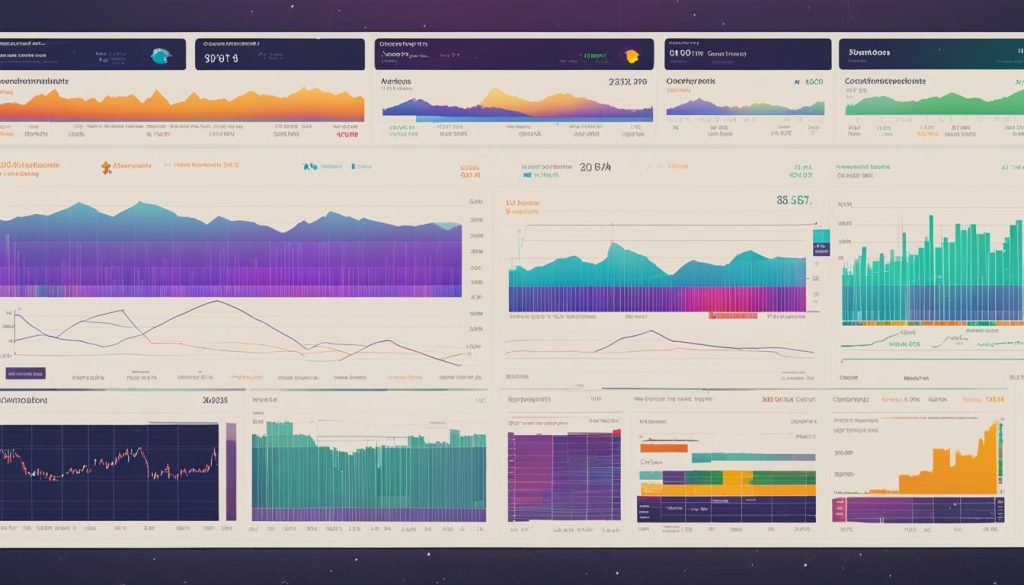Welcome to our comprehensive guide on cryptocurrency fundamental analysis. Understanding the fundamentals of a cryptocurrency is crucial for making informed investment decisions in the ever-evolving crypto market. In this guide, we will explore the techniques and tools used for analyzing cryptocurrency fundamentals, providing you with the knowledge to navigate the complex world of crypto investments.
Key Takeaways:
- Cryptocurrency fundamental analysis involves assessing the available information to determine the value of a cryptocurrency.
- Traditional fundamental analysis tools may not be applicable in the crypto market, so specific techniques and metrics need to be developed.
- Metric categories for crypto fundamental analysis include on-chain metrics, project metrics, and financial metrics.
- Fundamental analysis is important for evaluating the viability, technology, and financial health of a cryptocurrency.
- Factors to consider in fundamental analysis include usage and adoption, market competition, regulations, and investor sentiment.
What is Fundamental Analysis?
Fundamental analysis is an essential tool for evaluating the intrinsic value of assets or businesses. It involves examining internal and external factors to determine whether an asset is overvalued or undervalued. In the realm of cryptocurrency, traditional fundamental analysis techniques may not always be applicable. Therefore, it is crucial to develop specific approaches and tools for analyzing the fundamentals of crypto assets.
Fundamental analysis in the cryptocurrency space goes beyond simply looking at financial statements or economic indicators. It encompasses a broader scope, taking into account the unique characteristics of cryptocurrencies such as decentralization, consensus mechanisms, and technological advancements. By evaluating these factors, you can gain insights into the underlying value and growth potential of a cryptocurrency.
When conducting fundamental analysis, you need to consider various aspects such as the project’s whitepaper, the team behind the cryptocurrency, the technology stack, partnerships, and market demand. These components play a significant role in determining the viability and potential success of a crypto asset. By analyzing these fundamental factors, you can make informed investment decisions and identify opportunities in the ever-evolving cryptocurrency market.
Unlike traditional financial markets, the crypto space is highly dynamic and subject to rapid changes. Therefore, it is crucial to stay updated with the latest news, industry trends, and regulatory developments that can impact the fundamentals of cryptocurrencies. By combining comprehensive research, strong metrics, and critical analysis, you can gain a deeper understanding of the fundamentals and navigate the crypto market with confidence.

Fundamental Analysis Key Takeaways:
- Fundamental analysis evaluates the intrinsic value of assets or businesses.
- Traditional fundamental analysis techniques may not be directly applicable to cryptocurrencies.
- Specific approaches and tools must be developed for analyzing crypto fundamentals.
- Consider unique factors such as decentralization, consensus mechanisms, and technological advancements in cryptocurrency analysis.
- Examine aspects like the project’s whitepaper, team, technology, partnerships, and market demand in fundamental analysis.
- Stay updated with news, industry trends, and regulatory developments in the dynamic crypto space.
| Pros of Fundamental Analysis | Cons of Fundamental Analysis |
|---|---|
| Provides insights into the underlying value and growth potential of cryptocurrencies. | Can be time-consuming and require in-depth research. |
| Helps identify opportunities and make informed investment decisions. | Does not predict short-term price movements accurately. |
| Considers factors beyond price history and trading volume. | May not account for market sentiment and irrational investor behavior. |
Metrics for Crypto Fundamental Analysis
When it comes to fundamental analysis in the world of cryptocurrencies, it is essential to have a set of reliable metrics that can provide valuable insights. These metrics serve as the foundation for evaluating the potential value and growth prospects of a cryptocurrency. In this section, we will explore the key metrics that you should consider when conducting fundamental analysis for crypto investments.
On-chain Metrics
One of the most crucial aspects of crypto fundamental analysis is analyzing on-chain metrics. These metrics provide insights into the activities happening on the blockchain and can help determine the network’s adoption and usage. Some essential on-chain metrics to consider include:
- Transaction count: The total number of transactions on the blockchain.
- Transaction value: The total value transferred through transactions.
- Active addresses: The number of unique addresses participating in transactions.
- Fees paid: The total fees paid by users for transactions.
- Hash rate: The computational power of the network.
- Amount staked: The total number of coins staked in a proof-of-stake network.
Project Metrics
In addition to on-chain metrics, evaluating project-specific metrics is essential in fundamental analysis for cryptocurrencies. These metrics revolve around the project’s whitepaper and the team behind it. Consider the following project metrics:
- Whitepaper analysis: Assess the project’s whitepaper, its goals, technology, and potential impact.
- Team analysis: Evaluate the experience and credibility of the project’s team members.
- Partnerships: Examine the partnerships and collaborations the project has formed.
Financial Metrics
Financial metrics play a vital role in fundamental analysis for cryptocurrencies. These metrics help assess the project’s financial health, funding sources, and revenue streams. Some important financial metrics to consider include:
- Funding sources: Understand how the project is funded, whether through ICOs, private sales, or other means.
- Revenue streams: Analyze the sources of revenue for the project and evaluate their sustainability.
- Tokenomics: Assess the token distribution, token supply, and any mechanisms that affect the token’s value.
Table: A Comparative Analysis of On-chain Metrics
| Metric | Description | Importance |
|---|---|---|
| Transaction count | The total number of transactions on the blockchain. | Provides insights into network activity and adoption. |
| Transaction value | The total value transferred through transactions. | Indicates the level of value being exchanged on the network. |
| Active addresses | The number of unique addresses participating in transactions. | Reflects the number of active users on the network. |
| Fees paid | The total fees paid by users for transactions. | Shows the cost of using the network and the demand for transactions. |
| Hash rate | The computational power of the network. | Indicates the security and overall strength of the network. |
| Amount staked | The total number of coins staked in a proof-of-stake network. | Reflects the level of network participation and consensus. |
By considering these metrics in your fundamental analysis, you can gain valuable insights into the potential value and growth prospects of cryptocurrencies. These metrics provide a comprehensive understanding of the network activity, project fundamentals, and financial health, enabling you to make informed crypto investment decisions.
Importance of Fundamental Analysis in Crypto Investment
Fundamental analysis plays a crucial role in making investment decisions in the crypto market. While technical analysis focuses on price trends and market sentiment, fundamental analysis delves into the underlying factors that determine a cryptocurrency’s value. By evaluating the fundamentals, you can gain a deeper understanding of the cryptocurrency’s viability, growth potential, and financial health.
When evaluating cryptocurrency fundamentals, you consider various aspects such as the project’s technology, team, adoption rate, competition, and regulatory environment. These factors provide valuable insights into the cryptocurrency’s market valuation and future prospects. For instance, analyzing the project’s technology can help you assess its scalability, security, and potential for real-world applications.
Additionally, conducting a thorough financial analysis allows you to evaluate the project’s revenue streams, funding sources, and financial stability. This information is crucial in determining the long-term sustainability of the cryptocurrency and its potential for growth. By combining fundamental analysis with other research techniques, you can make more informed investment decisions and strategically allocate your resources in the crypto market.

Evaluating Cryptocurrency Fundamentals: A Comprehensive Approach
When evaluating cryptocurrency fundamentals, it’s essential to take a comprehensive approach. This includes analyzing both the quantitative and qualitative aspects of the project. Quantitative analysis involves examining metrics such as transaction volume, user adoption, and blockchain activity. Qualitative analysis, on the other hand, focuses on understanding the project’s technology, team, and competitive advantages.
By combining quantitative and qualitative analysis, you can gain a holistic view of the cryptocurrency’s fundamentals and make more accurate predictions about its future performance. This multi-dimensional approach is especially important in the dynamic and rapidly evolving crypto market, where factors such as regulatory changes, market trends, and investor sentiment can have a significant impact on a cryptocurrency’s value.
| Factors to Consider | Description |
|---|---|
| Technology | Evaluate the project’s technology, scalability, security, and potential real-world applications. |
| Team | Analyze the team’s experience, expertise, and track record in the crypto industry. |
| Adoption Rate | Assess the cryptocurrency’s user adoption, network effect, and community support. |
| Competition | Consider the competitive landscape and potential market share of the cryptocurrency. |
| Regulatory Environment | Examine the regulatory framework and legal compliance of the cryptocurrency. |
| Financial Stability | Evaluate the project’s funding sources, revenue streams, and financial outlook. |
By considering these factors and conducting thorough fundamental analysis, you can gain valuable insights into a cryptocurrency’s potential for long-term growth and make informed investment decisions in the crypto market.
Factors to Consider in Fundamental Analysis for Cryptocurrency Investments
When it comes to fundamental analysis for cryptocurrency investments, there are several crucial factors that you need to consider. These factors can provide valuable insights into the potential value and future prospects of a cryptocurrency, helping you make informed investment decisions.
Crypto Market Trends Analysis: One of the key factors to assess is the current trend in the cryptocurrency market. Analyzing market trends can give you an idea of whether a particular cryptocurrency is gaining traction or losing popularity. Look for indications of increasing adoption, positive sentiment, and growing interest from investors and institutions. Conversely, be cautious of negative trends, such as declining user activity or regulatory uncertainty.
Fundamental Analysis Metrics: To evaluate the fundamentals of a cryptocurrency, you need to consider specific metrics that provide insights into its underlying value. These metrics can vary depending on the type of cryptocurrency, but common ones include transaction volume, network activity, development updates, partnerships, and community engagement. Analyzing these metrics can help you gauge the health and potential growth of a cryptocurrency.
Economic and Regulatory Factors: Another important aspect of fundamental analysis is assessing the economic and regulatory environment in which a cryptocurrency operates. Factors such as government regulations, legal frameworks, tax policies, and global economic trends can significantly impact the value and viability of a cryptocurrency. Stay updated on the latest news and developments in these areas to make informed investment decisions.
By considering these fundamental analysis factors, including crypto market trends analysis, fundamental analysis metrics, and economic and regulatory factors, you can gain a deeper understanding of the potential value and risks associated with different cryptocurrencies. Remember that fundamental analysis is just one piece of the puzzle, and it’s important to combine it with technical analysis and other relevant information to make well-rounded investment decisions.
Effective Fundamental Analysis Techniques in Crypto
When it comes to making informed investment decisions in the cryptocurrency market, mastering fundamental analysis techniques is essential. By analyzing the fundamental aspects of cryptocurrencies, you can gain valuable insights into their potential value and make more informed investment decisions. Here are some effective techniques to consider:
Detailed Market Data Analysis
One fundamental analysis technique is conducting a thorough analysis of market data. This involves evaluating various factors such as market trends, supply and demand dynamics, and trading volume. By analyzing this data, you can identify patterns and trends that may impact the value of a cryptocurrency.
For example, you can analyze historical price data to identify potential support and resistance levels. This can help you make more accurate predictions about future price movements and determine optimal entry and exit points for your investments.
Evaluation of the Project Team and Community
Another important aspect of fundamental analysis is evaluating the project team and community behind a cryptocurrency. A strong and capable team increases the likelihood of successful project execution and adoption. Analyzing the team’s qualifications, experience, and track record can provide valuable insights into the cryptocurrency’s potential for long-term success.
Additionally, assessing the size and engagement of the cryptocurrency’s community can provide insights into its adoption and potential for growth. A strong and active community can contribute to the success of a cryptocurrency by driving adoption, developing applications, and supporting the project’s ecosystem.
Assessment of Regulatory Changes
Regulatory changes can significantly impact the value and future prospects of cryptocurrencies. Fundamental analysis involves monitoring and assessing any regulatory developments that may affect the cryptocurrency market. This includes changes in laws, regulations, or policies that may impact the legality, taxation, or trading of cryptocurrencies.
By staying informed about regulatory changes, you can anticipate potential risks and opportunities in the market. This allows you to adjust your investment strategy accordingly and make more informed decisions.
By incorporating these fundamental analysis techniques into your investment approach, you can enhance your understanding of cryptocurrencies and make more informed investment decisions. Remember that fundamental analysis should be complemented with other forms of analysis, such as technical analysis, to gain a comprehensive view of the market and maximize your investment potential.

Technical Analysis vs. Fundamental Analysis in Crypto
When it comes to analyzing cryptocurrencies, investors have two primary approaches: technical analysis and fundamental analysis. Technical analysis focuses on price history and trading volume to predict future price movements. On the other hand, fundamental analysis delves into the factors that determine a cryptocurrency’s intrinsic value. Let’s explore the key differences between these two methods.
Technical analysis involves studying price charts and using various indicators to identify patterns and trends. Traders who rely on technical analysis believe that historical price data can offer insights into future price direction. They use indicators such as moving averages, MACD, RSI, and Fibonacci retracements to make buy or sell decisions. Technical analysis can be helpful for short-term traders looking for entry and exit points based on chart patterns and market sentiment.
On the other hand, fundamental analysis focuses on the underlying factors that drive a cryptocurrency’s value. It involves evaluating a project’s technology, team, adoption rate, competition, and regulatory landscape. Fundamental analysts believe that these factors provide a more accurate assessment of a cryptocurrency’s long-term potential. By understanding the fundamentals of a project, investors can make informed decisions based on the asset’s intrinsic value.
While technical analysis is more suitable for short-term traders, fundamental analysis is often favored by long-term investors seeking to identify undervalued cryptocurrencies with strong growth potential. Some investors combine both methods to gain a more comprehensive understanding of the market. By examining both the technical and fundamental aspects of a cryptocurrency, investors can make more informed decisions and manage risk effectively.
Comparing Technical and Fundamental Analysis
| Technical Analysis | Fundamental Analysis |
|---|---|
| Relies on historical price data and chart patterns | Evaluates the intrinsic value of a cryptocurrency |
| Uses indicators to predict future price movements | Considers technology, team, adoption, competition, and regulations |
| Focuses on short-term trading opportunities | Provides insights for long-term investment decisions |
| Primarily based on technical indicators and chart analysis | Relies on research, analysis, and understanding of the project |

Combining fundamental and technical analysis can provide a more well-rounded approach to crypto analysis. While technical analysis can help with short-term trading decisions, fundamental analysis provides a deeper understanding of a cryptocurrency’s long-term potential. By considering both methods, investors can make more informed decisions and potentially maximize their returns.
Combining Fundamental and Technical Analysis in Crypto
When it comes to analyzing cryptocurrencies, combining fundamental and technical analysis can provide a comprehensive approach that maximizes insights and opportunities for investors. By integrating these two methodologies, you can gain a deeper understanding of a cryptocurrency’s growth potential and make informed investment decisions.
Utilizing fundamental analysis software for cryptocurrencies can enhance your research process by providing access to valuable data and metrics. These software platforms offer comprehensive tools and reports that allow you to evaluate the fundamental aspects of cryptocurrencies, such as the project team, the technology behind the coin, and the market competition. By utilizing these platforms, you can conduct thorough research and gain insights into the potential value and future prospects of a cryptocurrency.
Furthermore, combining fundamental analysis with technical analysis tools and indicators can help identify optimal entry and exit points for your investments. Technical analysis focuses on price history and trading volume, allowing you to identify patterns and trends in the market. By overlaying technical analysis on your fundamental research, you can validate your investment decisions and increase the probability of success.
It is important to note that combining fundamental and technical analysis requires a holistic approach and a deep understanding of both methodologies. By continually refining your analysis techniques and staying updated with the latest market trends, you can develop a well-rounded investment strategy that incorporates the best of both worlds.

Table: Advantages of Combining Fundamental and Technical Analysis
| Advantages | Explanation |
|---|---|
| Diversified Insights | Combining fundamental and technical analysis allows you to approach cryptocurrency investment from different angles, providing diverse insights into the market. |
| Validation of Investment Decisions | By overlaying technical analysis on your fundamental research, you can validate your investment decisions and increase the probability of success. |
| Identifying Market Trends | Technical analysis helps identify market trends, while fundamental analysis provides insights into the underlying factors driving those trends. |
| Maximizing Opportunities | Combining fundamental and technical analysis allows you to identify potential investment opportunities that may be missed by using only one approach. |
Conclusion
By mastering fundamental analysis techniques in cryptocurrency, you can navigate the crypto market with confidence and make informed investment decisions. Conducting comprehensive research and analysis of both the fundamentals and technical aspects of cryptocurrencies is essential for successful crypto market analysis and cryptocurrency research.
Utilizing strong metrics and crypto analysis strategies, such as evaluating on-chain metrics, project metrics, and financial metrics, can provide valuable insights into the potential value and growth prospects of a cryptocurrency. Understanding factors like usage and adoption, market competition, regulatory environment, and investor sentiment can further enhance your analysis.
Remember to combine fundamental and technical analysis to gain a comprehensive understanding of a cryptocurrency’s growth potential. This allows you to identify optimal entry and exit points for your investments. Make use of fundamental analysis software and research platforms to streamline your analysis process.
In conclusion, by incorporating fundamental analysis techniques, conducting thorough research, and analyzing both the fundamentals and technical aspects of cryptocurrencies, you can maximize investment returns and minimize risks in the dynamic crypto market.
FAQ
What is fundamental analysis?
Fundamental analysis is an approach used by investors to determine the intrinsic value of an asset or business by looking at internal and external factors.
How does fundamental analysis apply to cryptocurrencies?
Fundamental analysis for cryptocurrencies involves developing specific techniques and tools to assess the value and viability of crypto assets.
What metrics are used in fundamental analysis for cryptocurrencies?
Metrics can include on-chain metrics, project metrics, and financial metrics, which provide insights into the blockchain data, project whitepapers, and financial aspects of cryptocurrencies.
Why is fundamental analysis important in crypto investment?
Fundamental analysis helps assess the underlying technology, viability, and financial health of a cryptocurrency, enabling informed investment decisions.
What factors should be considered in fundamental analysis for cryptocurrency investments?
Usage and adoption, market competition, regulatory environment, and investor sentiment are important factors to evaluate in fundamental analysis for cryptocurrencies.
How can effective fundamental analysis techniques be applied in the crypto market?
By understanding the underlying technology, evaluating market dynamics, regulatory changes, and project teams, investors can make informed decisions based on thorough analysis.
What is the difference between technical analysis and fundamental analysis in crypto?
Technical analysis focuses on price history and trading volume, while fundamental analysis delves into factors that determine a cryptocurrency’s value.
Can fundamental and technical analysis be combined for crypto investment?
Yes, combining fundamental and technical analysis provides a comprehensive understanding of a cryptocurrency’s growth potential and helps identify optimal entry and exit points.
How can fundamental analysis techniques be enhanced in the crypto market?
Utilizing fundamental analysis software and research platforms can enhance the effectiveness of analysis and decision-making in the crypto market.

